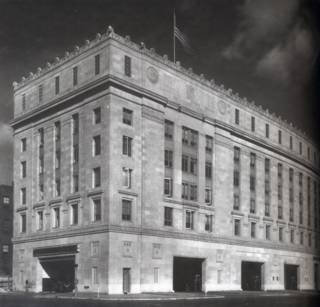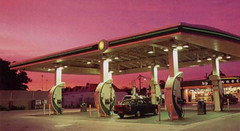Now that's a gas station!

Standard Oil Building, Washington, DC. Demolished in favor of a building for the US Department of Labor. From pages 462-463 in Capital Losses. Thank you to Peter Sefton for the scan.
 Capital Losses by James Goode is an excellent book that pictures a variety of majestic buildings and structures in the District of Columbia that have been demolished over the years. If you haven't ever looked at this book, you must. There are copies in the Washingtoniana collection of the main branch of the DC Library. The first edition has been out-of-print for many years, a second edition was published in 2003.
Capital Losses by James Goode is an excellent book that pictures a variety of majestic buildings and structures in the District of Columbia that have been demolished over the years. If you haven't ever looked at this book, you must. There are copies in the Washingtoniana collection of the main branch of the DC Library. The first edition has been out-of-print for many years, a second edition was published in 2003.The entry on the Standard Oil Building explains that this building "was billed as the world's largest (and probably grandest) service station. It was comparable in scale, materials, and classically inspired style to Washington's finest government buildings." Known as the Esso Building, it had a gas station, parking, repair garage, and three floors of offices that were not used by the company were rented to other companies such as Ford Motor, Prudential Insurance, and GE. You can see gasoline pumps to the right in many of the bays.
Anyway, in 2000 and 2001 when BP was trying to convert most of the square, including the 300 block of H Street NE into a 50,000 square foot gas station complex, I countered with this photo (from the first edition) to try to get them to think a little more broadly about the possibilities.
They had no interest in building anything other than the traditional BP Connect format, which they believe is essential to communicating the value of the BP Brand in the 21st Century.
 An urban-design unfriendly BP Connect station.
An urban-design unfriendly BP Connect station.Apparently, because of the increase in value of this land, given its proximity to Union Station and because of the value of the surrounding developments that are occuring, BP is being bought out of its lease, and a different, mixed-use project is likely to result.
In any case, as land becomes more expensive, more urban and urbane formats, accomodating gasoline stations as part of a vertical mixed-use project, seem to be in order. Some communities have passed zoning regulations which require putting the pumps behind buildings. Building above seems to be a direction that needs to be encouraged as well.



0 Comments:
Post a Comment
<< Home